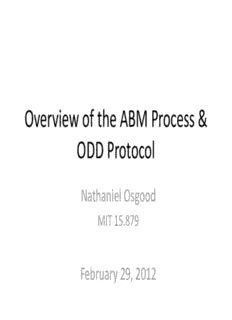
Stock & Flows 3 & Overview of the Modeling Process PDF
Preview Stock & Flows 3 & Overview of the Modeling Process
Overview of the ABM Process & ODD Protocol Nathaniel Osgood MIT 15.879 February 29, 2012 Model Specification Mechanisms Stock & Flow Models: Agent-Based Modeling: “Fox “Hedgehog Knowledge” Knowledge” • Small modeling vocabulary • Large modeling vocabulary • Power lies in combination of • Different subsets of a few elements vocabulary used for different models • Analysis conducted predominantly in terms of • Power in flexibility & elements of model combination of elements vocabulary • Variety in analysis focus ABMs: Larger Model Vocabulary & Needs • Events • Subtyping • Multiple mechanisms for • Mobility & movement describing dynamics • Graphical interfaces – State diagrams • Data output mechanisms – Stock and flow • Stochastics complicated – Custom update code – Scenario result interpretation • Inter-Agent communication – Calibration (sending & receiving) – Sensitivity analysis • Multiple types of transitions • Synchronous & • Diverse types of agents asynchronous distinction, • Spatial & topological concurrency connectivity & patterning The Overview, Design concepts, and Details (ODD) Protocol for ABM Design • Consensus protocol derived from panel fo ABM modelers • Primary focus: Specification protocol – To help understand, communicate & reproduce ABMs • Secondary benefit: Process for ABM design ODD: 3 Broad Components • Overview: model goals & high level scope & design • Design concepts: Different aspects of design being considered • Remaining elements Overview of Modeling Process • Typically conducted with an interdisciplinary team • An ongoing process of refinement • Best: Iteration with modeling, intervention implementation, data collection • Observation: – Traditionally, the focus in ABM has been on insights gained from the model delivered – Often it is the modeling process itself – rather than the models created – that offers the greatest value ABM Modeling Process Overview ODD: A Key Deliverable! ODD: Overview Design & high-level design components & details components Learning Reference mode Specification & Parameter sensitivity environm Specification of reproduction investigation of analysis Problem/research State charts ents (e.g. • Parameters intervention scenarios question articulation Parameter & state Matching of DISimS) • Quantitative causal Cross-validation Investigation of variables intermediate time Patterns for explanation relations Formal hypothetical external Visualizat Qualitative State charts series • Decision/behavior w/Discovered conditions ions Model scope/boundary Influence & Causal loop rules Matching of Patterns selection (endogeous, diagrams Cross-scenario Transitions observed data points exogenous,ignored) Multi-agent interaction Robustness tests comparisons (e.g. CEA) • Interactions diagrams Constrain to sensible Extreme value tests Messaging Key entities & their Process flow structure bounds &handlers relationships Key events Structural sensitivity Unit checking Resources Agents (&collectives)R ough model time & analysis • Relationship Problem domain tests Environment spatial extent dynamics Nesting hierarchy orO bservers to measure • Mobility network diagrams outputs dynamics Output of interest • Initial conditions Recall: Coevolution Observations/ Evaluation External World Mental Model Actions & Choice of Observations Simulated Dynamics Formal Modeling Artifacts ABM Modeling Process Overview ODD: ODD: Overview Design & high-level design components & details components Learning Reference mode Specification & Parameter sensitivity environm Specification of reproduction investigation of analysis Problem/research State charts ents (e.g. • Parameters intervention scenarios question articulation Parameter & state Matching of DISimS) • Quantitative causal Cross-validation Investigation of variables intermediate time Patterns for explanation relations Formal hypothetical external Visualizat Qualitative State charts series • Decision/behavior w/Discovered conditions ions Model scope/boundary Influence & Causal loop rules Matching of Patterns selection (endogeous, diagrams Cross-scenario Transitions observed data points exogenous,ignored) Multi-agent interaction Robustness tests comparisons (e.g. CEA) • Interactions diagrams Constrain to sensible Extreme value tests Messaging Key entities & their Process flow structure bounds &handlers relationships Key events Structural sensitivity Unit checking Resources Agents (&collectives)R ough model time & analysis • Relationship Problem domain tests Environment spatial extent dynamics Nesting hierarchy orO bservers to measure • Mobility network diagrams outputs dynamics Output of interest • Initial conditions ODD Overview: model goals & high level scope & design • Purpose • Definition of key elements during operation – Entities – States – Scales • Process overview and scheduling
Description: